High-Temperature Tensile Behaviour of GTAW Joints of P92 Steel and Alloy 617 for Two Different Fillers
Abstract
:1. Introduction
2. Experimental Details
3. Result and Discussion
3.1. Characterization of Base Metals and HAZ and Interface
3.2. HT Tensile Behaviour
3.3. Hardness Characteristic
4. Conclusions
Author Contributions
Funding
Institutional Review Board Statement
Informed Consent Statement
Data Availability Statement
Conflicts of Interest
References
- Abe, F. Research and Development of Heat-Resistant Materials for Advanced USC Power Plants with Steam Temperatures of 700 °C and Above. Engineering 2015, 1, 211–224. [Google Scholar] [CrossRef]
- Viswanathan, R.; Tanzosh, J.; Vitalis, B.; Power, R.U.S. Program on Materials Technology for Ultrasupercritical Coal-Fired Boilers; Springer: Berlin/Heidelberg, Germany, 2008. [Google Scholar]
- DuPont, J.N.; Lippold, J.C.; Kiser, S.D. Welding Metallurgy and Weldability of Nickel-Base Alloys; John Wiley & Sons: Hoboken, NJ, USA, 2009. [Google Scholar]
- Ren, W.; Swindeman, R. A review on current status of alloys 617 and 230 for gen IV nuclear reactor internals and heat exchangers. J. Press. Vessel Technol. Trans. ASME 2009, 131, 044002. [Google Scholar] [CrossRef]
- Ding, K.; Wang, P.; Liu, X.; Li, X.; Zhao, B.; Gao, Y. Formation of Lamellar Carbides in Alloy 617-HAZ and Their Role in the Impact Toughness of Alloy 617/9%Cr Dissimilar Welded Joint. J. Mater. Eng. Perform. 2018, 27, 6027–6039. [Google Scholar] [CrossRef]
- Boissonnet, G.; Bonnet, G.; Pedraza, F. Thermo-Physical Properties of HR3C and P92 Steels at High-Temperature. J. Mater. Appl. 2019, 8, 59–64. [Google Scholar] [CrossRef]
- Range, M. Inconel Alloy 617. Alloy Dig. 1972, 21, Ni-179. [Google Scholar] [CrossRef]
- Ding, K.; Ji, H.-J.; Liu, X.; Wang, P.; Zhang, Q.-L.; Li, X.-H.; Gao, Y.-L. Prevention of carbon migration in 9% Cr/CrMoV dissimilar welded joint by adding tungsten inert gas overlaying layer. J. Iron Steel Res. Int. 2018, 25, 847–853. [Google Scholar] [CrossRef]
- Ranjbar, K.; Dehmolaei, R.; Amra, M.; Keivanrad, I. Microstructure and properties of a dissimilar weld between alloy 617 and A387 steel using different filler metals. Weld World 2018, 62, 1121–1136. [Google Scholar] [CrossRef]
- Lee, J.H.; Hwang, J.H.; Park, Y.S.; Kim, T.M.; Bae, D.H.; Seo, W.B.; Han, J.W. Assessing mechanical properties of the dissimilar metal welding between P92 steels and alloy 617 at high temperature. J. Mech. Sci. Technol. 2016, 30, 4453–4457. [Google Scholar] [CrossRef]
- Francis, J.A.; Mazur, W.; Bhadeshia, H.K.D.H. Type IV cracking in ferritic power plant steels. Mater. Sci. Technol. 2006, 22, 1387–1395. [Google Scholar] [CrossRef]
- Abson, D.J.; Rothwell, J.S. Review of type IV cracking of weldments in 9–12% Cr creep strength enhanced ferritic steels. Int. Mater. Rev. 2013, 58, 437–473. [Google Scholar] [CrossRef]
- Xue, W.; Pan, Q.G.; Ren, Y.; Shang, W.; Zeng, H.; Liu, H. Microstructure and type IV cracking behavior of HAZ in P92 steel weldment. Mater. Sci. Eng. A 2012, 552, 493–501. [Google Scholar] [CrossRef]
- Sah, I.; Hwang, J.B.; Kim, W.G.; Kim, E.S.; Kim, M.H. High-temperature mechanical behaviors of diffusion-welded Alloy 617. Nucl. Eng. Des. 2020, 364, 110617. [Google Scholar] [CrossRef]
- Zhang, G.; Zhang, Q.; Yang, J.; Xie, Z.; Zhang, L.; Liu, R.; Li, G.; Wang, H.; Fang, Q.; Wang, X. Microstructures and Tensile Properties of 9Cr-F/M Steel at Elevated Temperatures. Materials 2022, 15, 1248. [Google Scholar] [CrossRef] [PubMed]
- Wang, Q.; Xin, R.; Wang, Z.; Han, Z.; Jiao, X.; Kang, J. Microstructure and its effect on high temperature tensile properties of T92/HR3C dissimilar weld joints. J. Manuf. Process. 2022, 82, 792–799. [Google Scholar] [CrossRef]
- Chen, G.; Song, Y.; Wang, J.; Liu, J.; Yu, X.; Hua, J.; Bai, X.; Zhang, T.; Zhang, J.; Tang, W. High-temperature short-term tensile test and creep rupture strength prediction of the T92/TP347H dissimilar steel weld joints. Eng. Fail. Anal. 2012, 26, 220–229. [Google Scholar] [CrossRef]
- Zhang, Y.; Jing, H.; Xu, L.; Han, Y.; Zhao, L.; Xiao, B. Microstructure and mechanical performance of welded joint between a novel heat-resistant steel and Inconel 617 weld metal. Mater. Charact. 2018, 139, 279–292. [Google Scholar] [CrossRef]
- Kim, M.Y.; Kwak, S.C.; Choi, I.S.; Lee, Y.K.; Suh, J.Y.; Fleury, E.; Jung, W.S.; Son, T.H. High-temperature tensile and creep deformation of cross-weld specimens of weld joint between T92 martensitic and Super304H austenitic steels. Mater. Charact. 2014, 97, 161–168. [Google Scholar] [CrossRef]
- Zhang, Y.; Li, K.; Cai, Z.; Pan, J. Creep rupture properties of dissimilar metal weld between Inconel 617B and modified 9%Cr martensitic steel. Mater. Sci. Eng. A 2019, 764, 138185. [Google Scholar] [CrossRef]
- Cao, J.; Gong, Y.; Yang, Z.G.; Luo, X.M.; Gu, F.M.; Hu, Z.F. Creep fracture behavior of dissimilar weld joints between T92 martensitic and HR3C austenitic steels. Int. J. Press. Vessels Pip. 2011, 88, 94–98. [Google Scholar] [CrossRef]
- Kumar, A.; Pandey, C. Some studies on dissimilar welds joint P92 steel and Inconel 617 alloy for AUSC power plant application. Int. J. Press. Vessels Pip. 2022, 198, 104678. [Google Scholar] [CrossRef]
- Kumar, A.; Pandey, C. Development and Evaluation of Dissimilar Gas Tungsten Arc-Welded Joint of P92 Steel/Inconel 617 Alloy for Advanced Ultra-Supercritical Boiler Applications. Metall. Mater. Trans. A 2022, 53, 3245–3273. [Google Scholar] [CrossRef]
- Kumar, A.; Pandey, C. Structural integrity assessment of Inconel 617/P92 steel dissimilar welds for different groove geometry. Sci. Rep. 2023, 13, 8061. [Google Scholar] [CrossRef]
- Kumar, A.; Pandey, S.M.; Pandey, C. Dissimilar weldments of ferritic/martensitic grade P92 steel and Inconel 617 alloy: Role of groove geometry on mechanical properties and residual stresses. Arch. Civ. Mech. Eng. 2023, 23, 54. [Google Scholar] [CrossRef]
- Rahman, M.S.; Priyadarshan, G.; Raja, K.S.; Nesbitt, C.; Misra, M. Characterization of high temperature deformation behavior of INCONEL 617. Mech. Mater. 2009, 41, 261–270. [Google Scholar] [CrossRef]
- Rao, C.V.; Srinivas, N.C.S.; Sastry, G.V.S.; Singh, V. Dynamic strain aging, deformation and fracture behaviour of the nickel base superalloy Inconel 617. Mater. Sci. Eng. A 2019, 742, 44–60. [Google Scholar] [CrossRef]
- Rodriguez, P. Serrated plastic flow. Bull. Mater. Sci. 1984, 6, 653–663. [Google Scholar] [CrossRef]
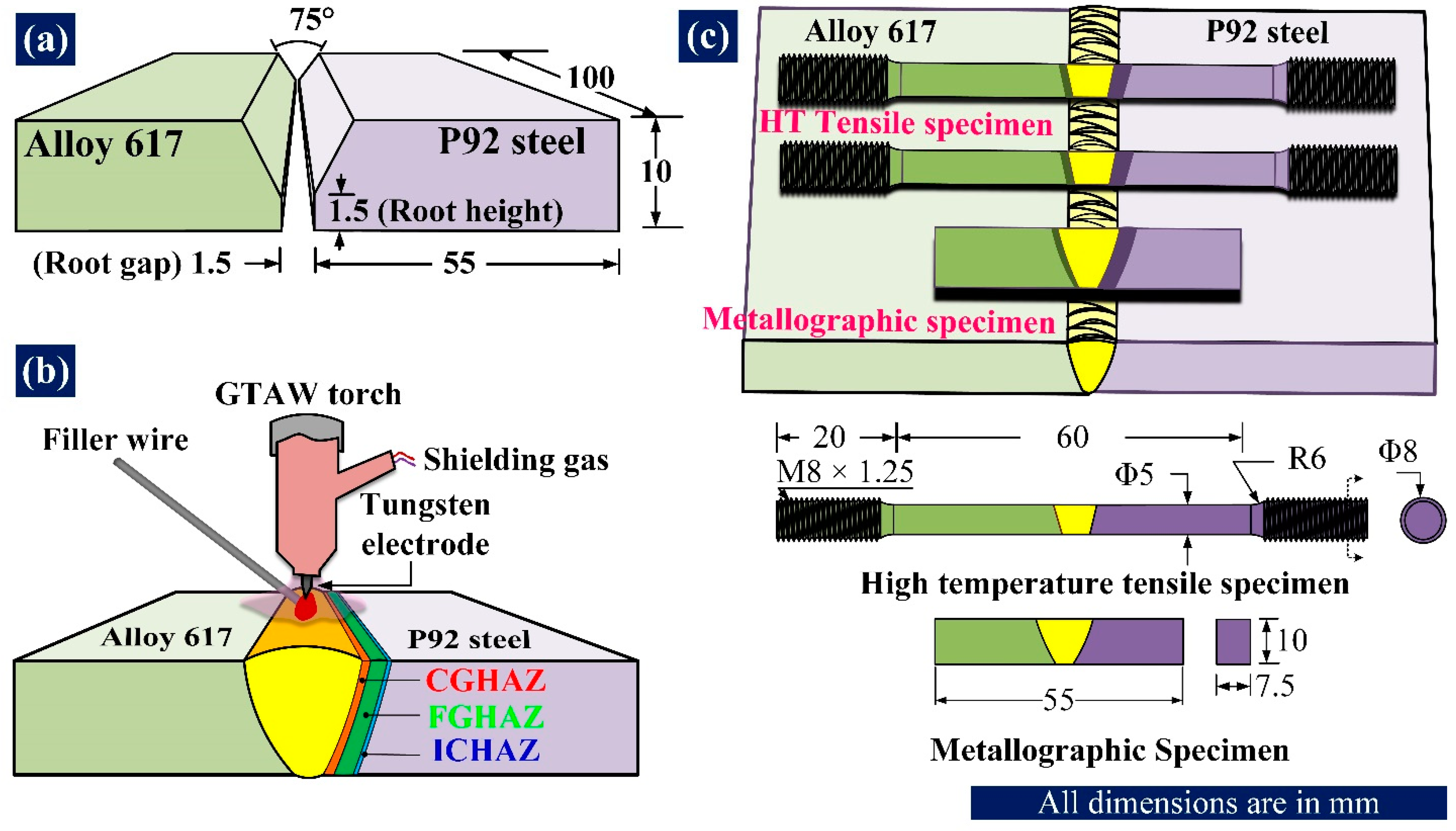


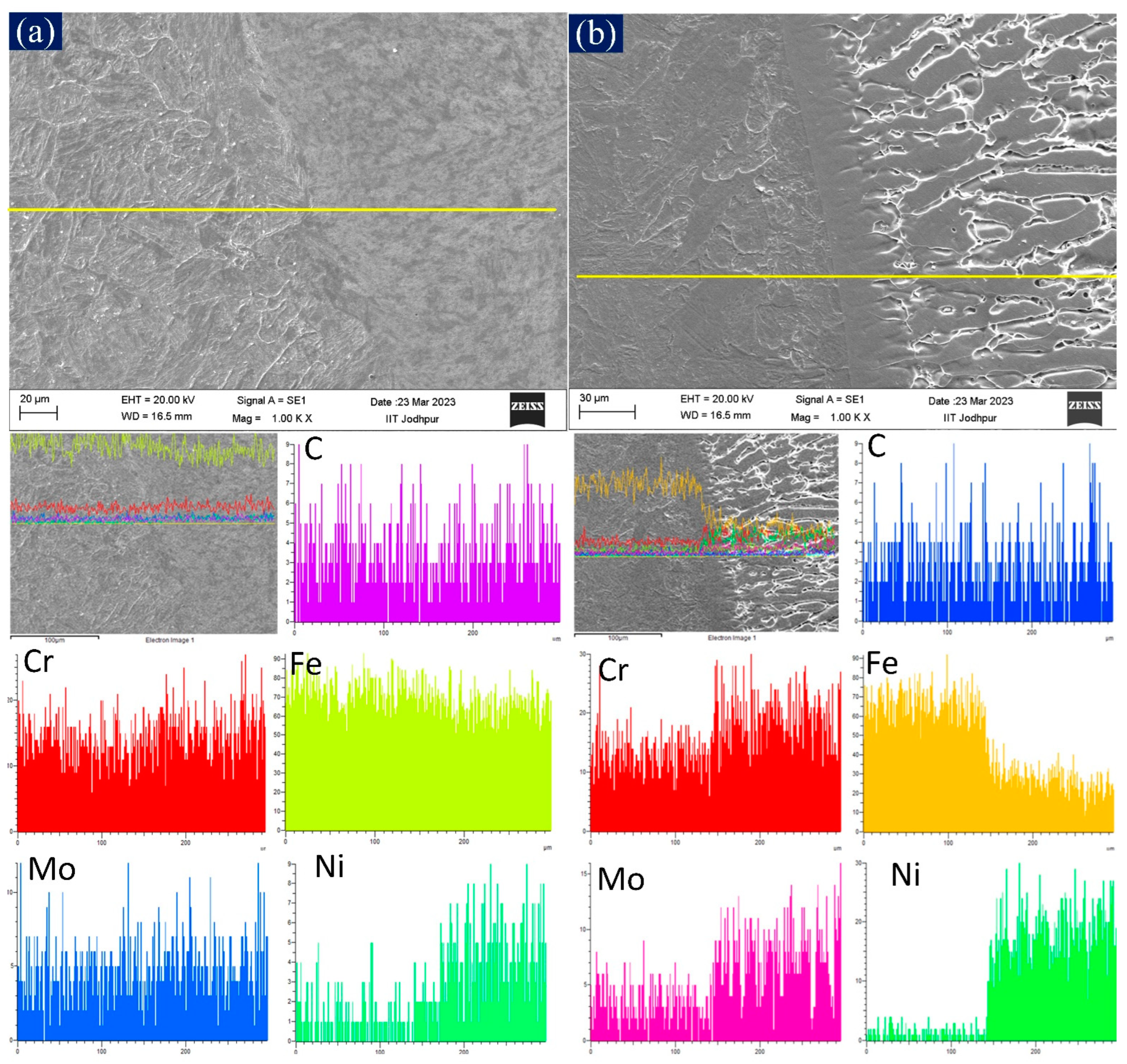

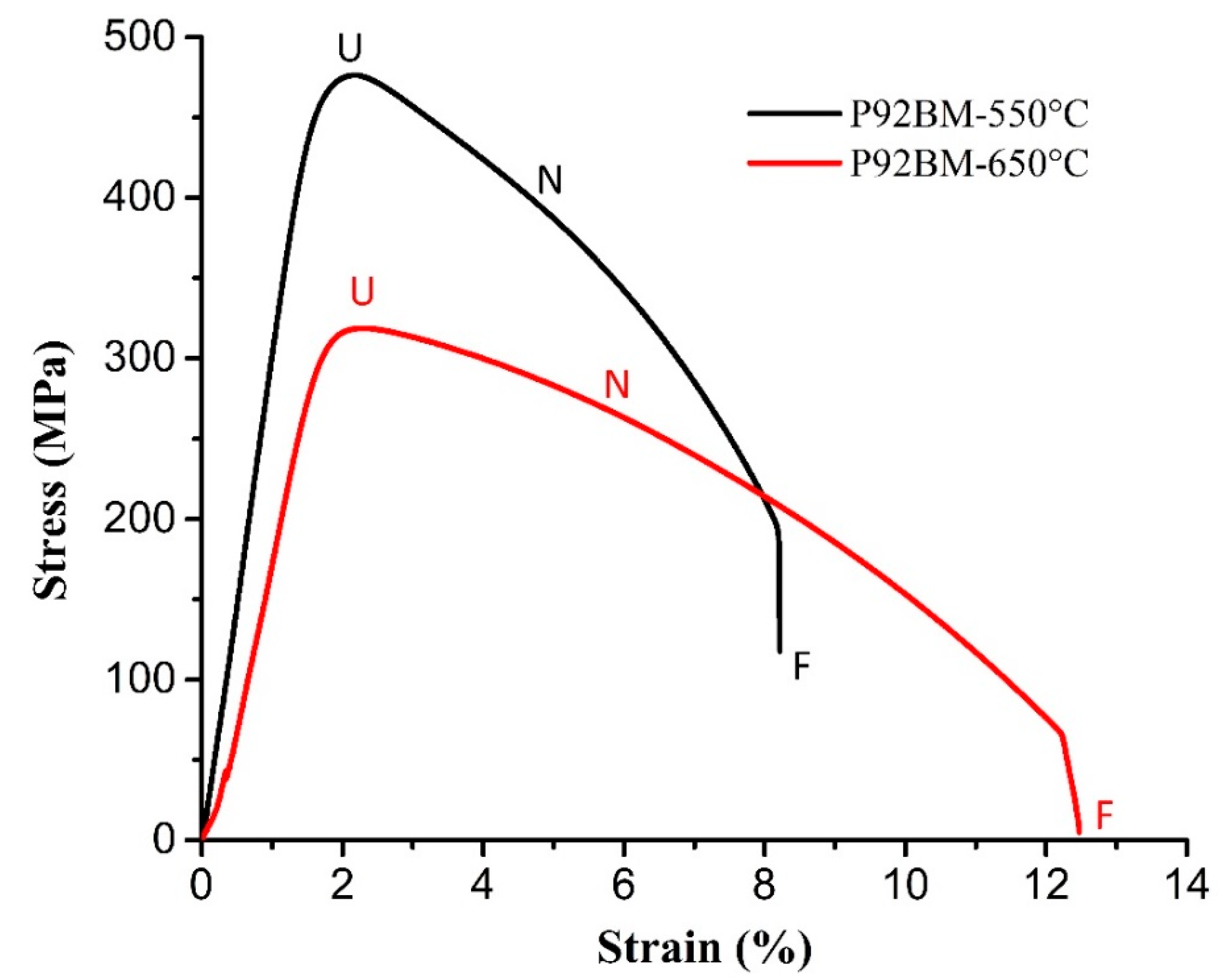
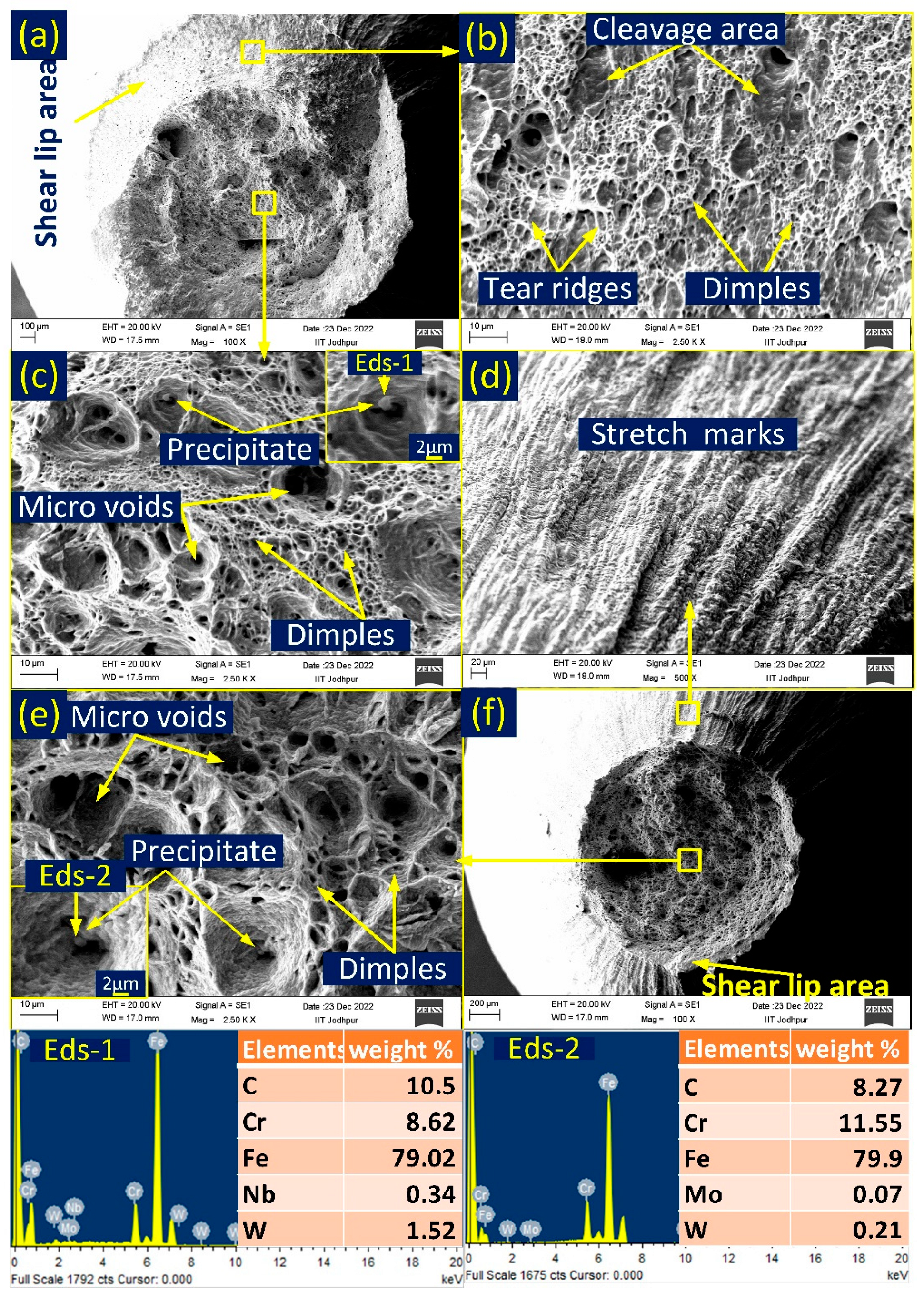



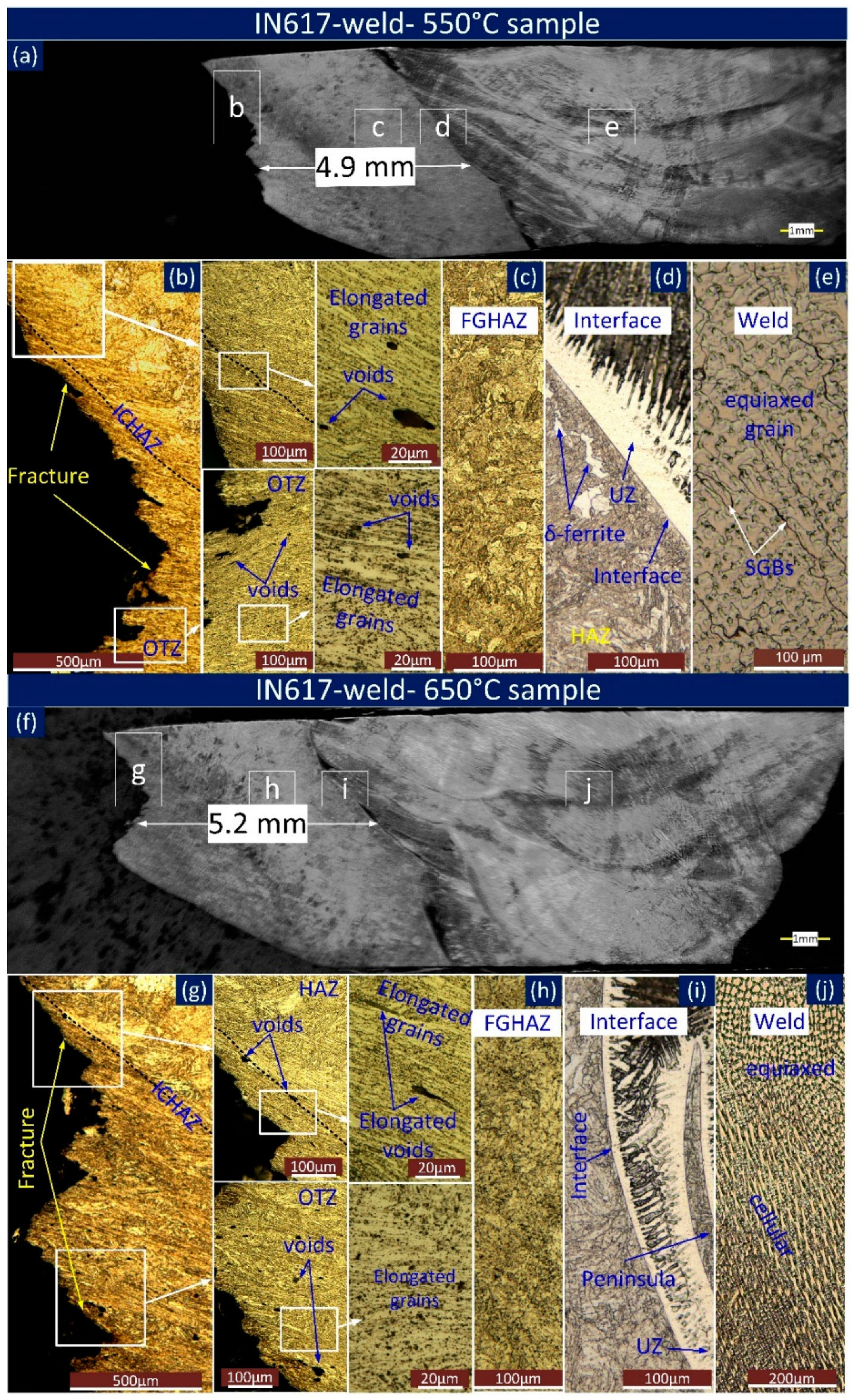

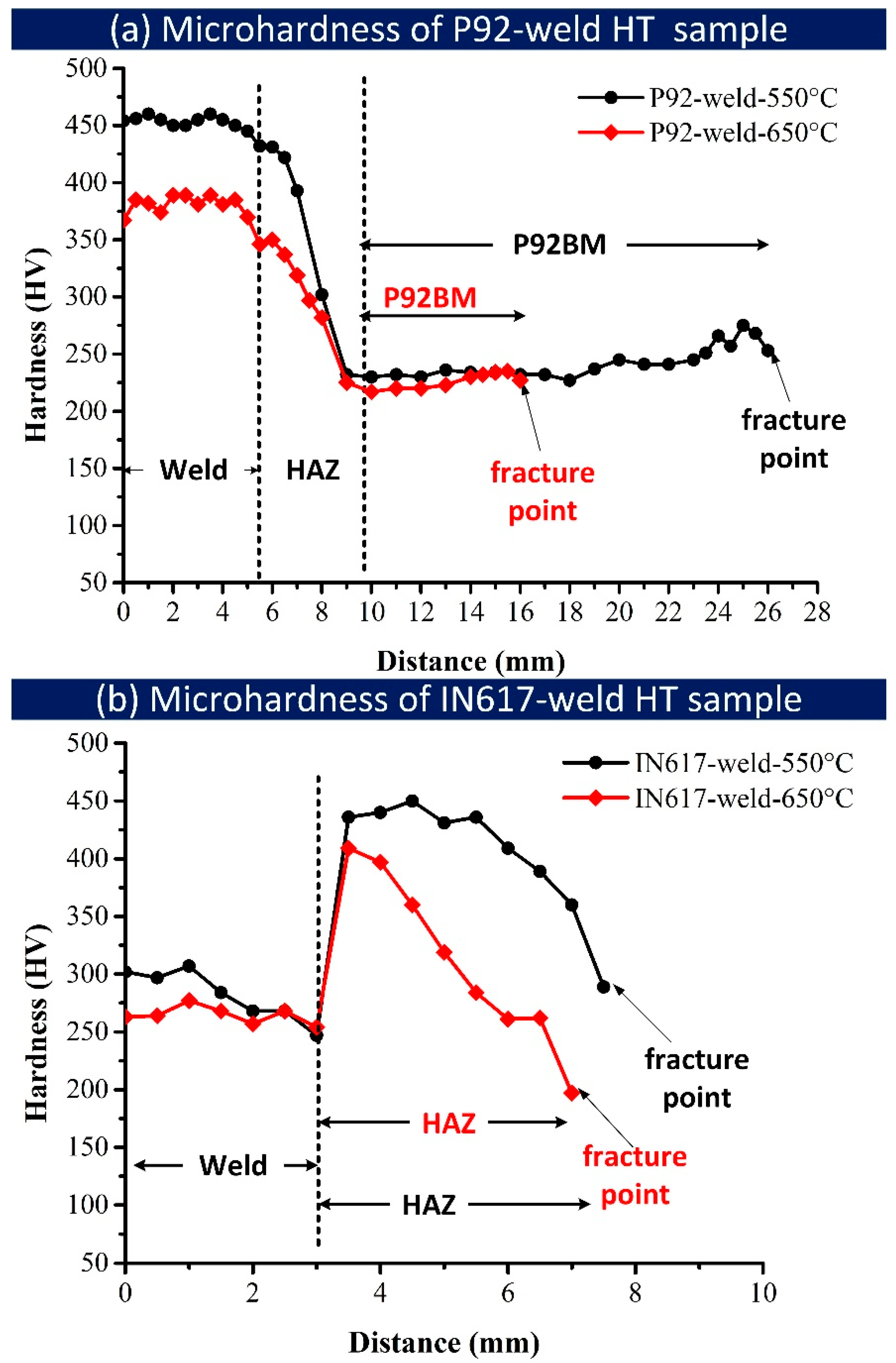
| RT [23] | 550 °C | 650 °C | |||||
|---|---|---|---|---|---|---|---|
| P92 BM | P92BM | IN617-Weld | P92-Weld | P92 BM | IN617-Weld | P92-Weld | |
| UTS (MPa) | 758 ± 6 | 476 | 466 | 402 | 319 | 357 | 269 |
| Yield strength (MPa) | 520 ± 8 | 332 | 230 | 220 | 291 | 245 | 205 |
| Elongation (%) | 33 ± 3 | 8.2 | 14.4 | 16 | 12.5 | 8.9 | 14 |
| Area reduction (%) | 69 | 58.8 | 51.5 | 80 | 86.8 | 69.7 | 91.2 |
| Fracture location | - | - | P92 ICHAZ | P92 BM | - | P92 ICHAZ | P92 BM |
Disclaimer/Publisher’s Note: The statements, opinions and data contained in all publications are solely those of the individual author(s) and contributor(s) and not of MDPI and/or the editor(s). MDPI and/or the editor(s) disclaim responsibility for any injury to people or property resulting from any ideas, methods, instructions or products referred to in the content. |
© 2023 by the authors. Licensee MDPI, Basel, Switzerland. This article is an open access article distributed under the terms and conditions of the Creative Commons Attribution (CC BY) license (https://creativecommons.org/licenses/by/4.0/).
Share and Cite
Kumar, A.; Sirohi, S.; Pandey, S.M.; Kumar, P.; Fydrych, D.; Pandey, C. High-Temperature Tensile Behaviour of GTAW Joints of P92 Steel and Alloy 617 for Two Different Fillers. Materials 2023, 16, 5880. https://doi.org/10.3390/ma16175880
Kumar A, Sirohi S, Pandey SM, Kumar P, Fydrych D, Pandey C. High-Temperature Tensile Behaviour of GTAW Joints of P92 Steel and Alloy 617 for Two Different Fillers. Materials. 2023; 16(17):5880. https://doi.org/10.3390/ma16175880
Chicago/Turabian StyleKumar, Amit, Sachin Sirohi, Shailesh Mani Pandey, Pradeep Kumar, Dariusz Fydrych, and Chandan Pandey. 2023. "High-Temperature Tensile Behaviour of GTAW Joints of P92 Steel and Alloy 617 for Two Different Fillers" Materials 16, no. 17: 5880. https://doi.org/10.3390/ma16175880
APA StyleKumar, A., Sirohi, S., Pandey, S. M., Kumar, P., Fydrych, D., & Pandey, C. (2023). High-Temperature Tensile Behaviour of GTAW Joints of P92 Steel and Alloy 617 for Two Different Fillers. Materials, 16(17), 5880. https://doi.org/10.3390/ma16175880





